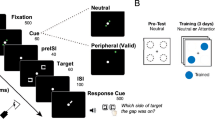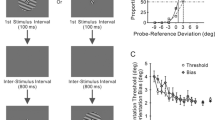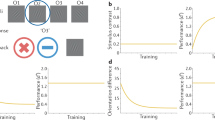Abstract
Practising simple visual tasks leads to a dramatic improvement in performing them. This learning is specific to the stimuli used for training. We show here that the degree of specificity depends on the difficulty of the training conditions. We find that the pattern of specificities maps onto the pattern of receptive field selectivities along the visual pathway. With easy conditions, learning generalizes across orientation and retinal position, matching the spatial generalization of higher visual areas. As task difficulty increases, learning becomes more specific with respect to both orientation and position, matching the fine spatial retinotopy exhibited by lower areas. Consequently, we enjoy the benefits of learning generalization when possible, and of fine grain but specific training when necessary. The dynamics of learning show a corresponding feature. Improvement begins with easy cases (when the subject is allowed long processing times) and only subsequently proceeds to harder cases. This learning cascade implies that easy conditions guide the learning of hard ones. Taken together, the specificity and dynamics suggest that learning proceeds as a countercurrent along the cortical hierarchy. Improvement begins at higher generalizing levels, which, in turn, direct harder-condition learning to the subdomain of their lower-level inputs. As predicted by this reverse hierarchy model, learning can be effective using only difficult trials, but on condition that learning onset has previously been enabled. A single prolonged presentation suffices to initiate learning. We call this single-encounter enabling effect 'eureka'.
This is a preview of subscription content, access via your institution
Access options
Subscribe to this journal
Receive 51 print issues and online access
$199.00 per year
only $3.90 per issue
Buy this article
- Purchase on Springer Link
- Instant access to full article PDF
Prices may be subject to local taxes which are calculated during checkout
Similar content being viewed by others
References
Felleman, D. J. & Van Essen, D. C. Distributed hierarchical processing in primate visual cortex. Cerebr. Cort. 1, 1–47 (1991).
Desimore, R. & Ungerleider, L. G. in Handbook of Neuropsychology (eds Boller, F. & Grafman, J.) Vol. 2 267–299 (Elsevier Science, Amsterdam, 1989).
Berardi, N. & Fiorentini, A. Interhemispheric transfer of visual information in humans: spatial characteristics. J. Physiol. 384, 633–647 (1987).
Karni, A. & Sagi, D. Where practice makes perfect: Evidence for primary visual cortex plasticity. Proc. Natl Acad. Sci. USA 88, 4966–4970 (1991).
Schoups, A. A., Vogels, R. & Orban, G. Human perceptual learning in identifying the oblique orientation: retinotopy, orientation specificity and monocularity. J. Physiol. 483, 797–810 (1995).
Poggio, T., Fahle, M. & Edelman, S. Fast perceptual learning in visual hyperacuity. Science 256, 1018–1021 (1992).
Treisman, A., Vieira, A. & Hayes, A. Automaticity and preattentive processing. Am. J. Psychol. 105, 341–362 (1992).
Nazir, T. & O'Regan, J. K. Some results on translation invariance in the human visual system. Spatial Vision 5, 81–100 (1990).
Ramachandran, V. S. & Braddick, O. Orientation specific learning in stereopsis. Perception 2, 371–376 (1973).
Fiorentini, A. & Berardi, N. Learning in grating waveform discrimination: specificity for orientation and spatial frequency. Vision Res. 21, 1149–1158 (1981).
Ahissar, M. & Hochstein, S. The role of attention in early perceptual learning. Proc. Natl Acad. Sci. USA 90, 5718–5722 (1993).
Fahle, M. & Edelman, S. Long term learning in vernier acuity: Effects of stimulus orientation, range and of feedback. Vision Res. 33, 397–412 (1993).
Ahissar, M. & Hochstein, S. Learning pop-out detection: specificities to stimulus characteristics. Vision Res. 36, 3487–3500 (1996).
Vogels, R. & Orban, G. A. The effect of practice on the oblique effect in line orientation judgments. Vision Res. 25, 1679–1687 (1985).
Beard, B. L., Levi, D. M. & Reich, L. N. Perceptual learning in parafoveal vision. Vision Res. 35, 1679–1690 (1995).
Ball, K. & Sekuler, R. A specific and enduring improvement in visual motion discrimination. Science 218, 697–698 (1982).
Liu, Z. Learning a visual skill that generalizes. NEC Tech. Rep. 95–177 (NEC, Princeton, 1995).
Schoups, A. & Orban, G. A. Interocular transfer in perceptual learning of a pop-out discrimination task. Proc. Natl Acad. Sci. USA 93, 7358–7362 (1996).
Treisman, A. & Gelade, G. A feature integration theory of attention. Cogn. Psychol. 12, 97–136 (1980).
Julesz, B. Textons, the elements of texture perception and their interactions. Nature 290, 91–97 (1981).
Karni, A. & Sagi, D. The time course of learning a visual skill. Nature 365, 250–252 (1993).
Dill, M. & Fahle, M. Limited translation invariance of human visual pattern recognition. Percept. Psychophys. (in the press).
Miller, J. Components of location probability effect in visual search tasks. Exp. Psychol.: Hum. Percept. Perform. 14, 453–471 (1988).
Treisman, A. The binding problem. Cur. Opin. Neurobiol. 6, 171–178 (1996).
Ullman, S. Sequence seeking and counter streams: a computational model for bidirectional information flow in the visual cortex. Cerebral Cortex 5, 1–11 (1995).
Nakayama, K. in Vision: coding and Efficiency (ed. Blakemore, C.) 411–442 (Cambridge Univ. Press, Cambridge, 1991).
Tsotsos, J. K. Analyzing vision at the complexity level. Behav. Brain Sci. 13, 423–469 (1990).
Rubin, N., Shapley, R. M., Nakayama, K. & Grossetete, A. Abrupt learning in illusory contour perception. Invest. Ophthalmol. Vis. Sci. 37, 859 (1996).
Ahissar, M. & Hochstein, S. Eureka: One shot viewing enables perceptual learning. Invest. Ophthalmol. Vis. Sci. 37, 3183 (1996).
Papathomas, T. V., Gorea, A. & Feher, A. Attending to attributes in double conjunction texture segregation: the role of color, luminance and orientation. Invest. Ophthalmol. Vis. Sci. 37, 2415 (1996).
Author information
Authors and Affiliations
Rights and permissions
About this article
Cite this article
Ahissar, M., Hochstein, S. Task difficulty and the specificity of perceptual learning. Nature 387, 401–406 (1997). https://doi.org/10.1038/387401a0
Received:
Accepted:
Issue Date:
DOI: https://doi.org/10.1038/387401a0
This article is cited by
Hand copy performance of young children and the illiterate, semi-illiterate, and literate adults
Current Psychology (2024)
The phase of plasticity-induced neurochemical changes of high-frequency repetitive transcranial magnetic stimulation are different from visual perceptual learning
Scientific Reports (2023)
Efficient neural codes naturally emerge through gradient descent learning
Nature Communications (2022)
Current directions in visual perceptual learning
Nature Reviews Psychology (2022)
Training with an auditory perceptual learning game transfers to speech in competition
Journal of Cognitive Enhancement (2022)
Comments
By submitting a comment you agree to abide by our Terms and Community Guidelines. If you find something abusive or that does not comply with our terms or guidelines please flag it as inappropriate.



